DREAMLIKE QUALITY
ON A WHITE-BLUE BACKGROUND
Greek chic attitude, non-stop party mood, beaches pulled straight from a postcard, multi-star restaurants and an enchanting Chora make up Mykonos, the island famous for its unsurpassed Cycladic beauty. Discover with us everything there is to know about the most popular Greek island and delve into the life of the locals.
It would be impossible to portray Mykonos in only a few sentences. But we hope to give you a little taste of this unique destination that has been in the world’s spotlight since 1950. Celebrities and stars of the time, including Onassis, Jackie O., Marlon Brando, have been flocking to this compelling islet of the Aegean Sea that became also a popular destination for the gay audience in the ‘70s. Since then, it has become an undeniable must for those seeking good life, beauty and wanderlust.
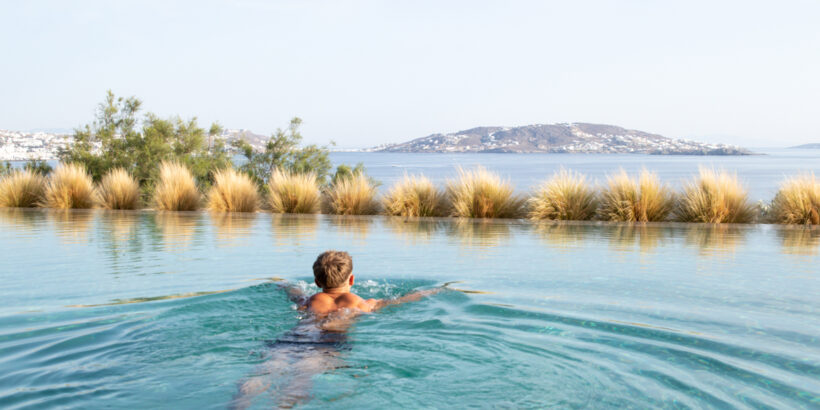
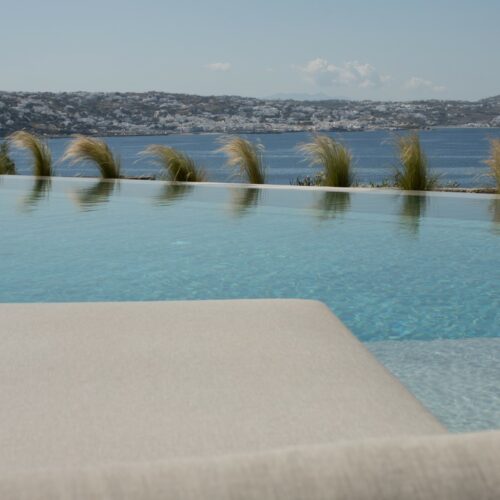
The ultimate beauty of Cyclades unfolds in Chora with its newly whitewashed alleys on a white-blue background. Whether you intend to or not, you will almost certainly get lost here, as Mykonos is a city-maze, built in this way to hide from the pirates in the old days! This, however, should not stop you, as it’s the perfect opportunity to explore the real side of the island, with its enchanting architecture, the white houses, the picturesque churches and the flowering bougainvilleas that make for an unforgettable scenery. In Chora, you’ll find the much-photographed Little Venice and the Mills and Gialos with the pelican, the island’s famous attraction, walking down the streets undisturbed.
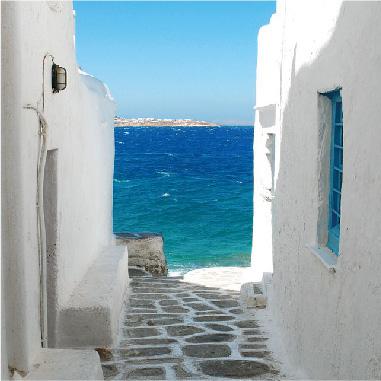
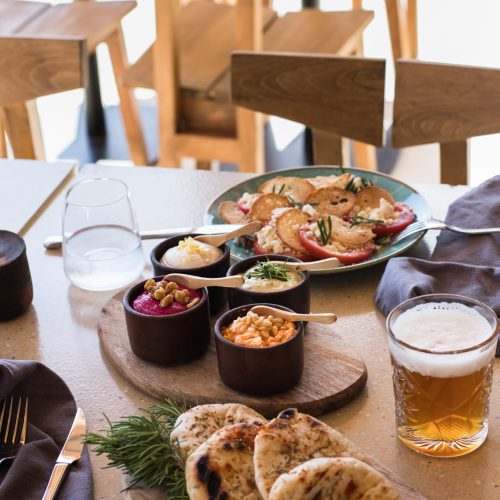
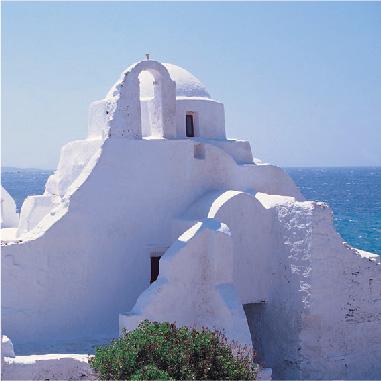

Outside Chora, the island’s charm stretches into the crystal clear waters of the infinite, yet divergent, beaches. Bohemian and party beach bars, beaches ‘flooded’ with people seeking their 5* services and otherworldly peaceful beaches are found even in August.
And then comes the night, with award-winning restaurants introducing you to modern Greek cuisine -and not only- flavours, and a nightlife that never ends. Cocktails and dancing, clubs with famous DJs on the decks, and beach parties that last until late in the morning initiate you to the world of an island that never sleeps and fulfils the needs of any traveller. What are you waiting for then? The clock is ticking.

MYKONOS ESSENTIALS
Kick back and enjoy a sunset cocktail in Little Venice. It might be a bit overcrowded, but it is definitely worth it. Sunset Catamaran Cruises are also an ideal alternative for unforgettable sunsets over the sea. Ask at the reception to cater to your needs.
Venture on an excursion to the neighbouring islands of Delos (and visit the captivating archaeological site) and Rinia. Ask at the reception for more information.
Visit Armenistis Lighthouse, one of the secret places of the island featuring dreamy views. Combine your visit with a Jeep Safari Tour, which we can arrange for you.
Ask at the reception for more information.
Swim in as many beaches of the island as you can.
Enjoy a wonderful picnic on a beach or at a place of your choice.
You may contact the reception to assist you.
Rent the vehicle of your choice and explore the island at your leisure.
Ask at the reception to make the necessary arrangements for you.
Visit a local winery, local creamery that produces famous “kapanisti” cheese or take part in cooking classes to get a true taste of the Cycladic gastronomy. Ask at the reception to book you a place.
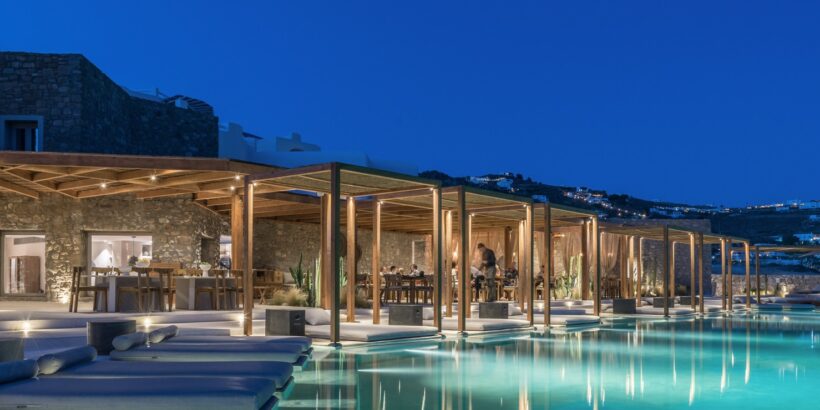
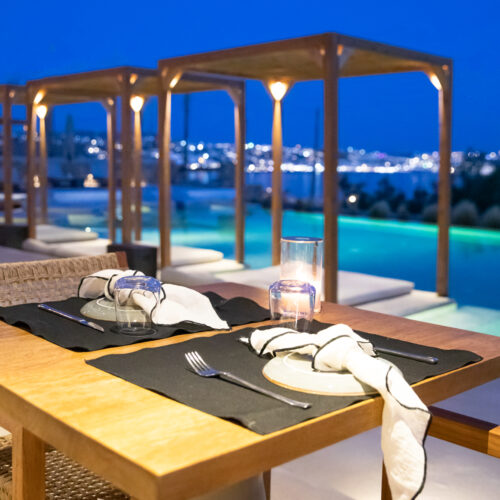
BEACHES
Mykonos’s most valuable tourist asset is its beaches. The island, and especially the southern coast, features an impressive number of beaches-some of the finest in the Aegean.Access is by hotel’s van upon arrangement at our reception.
Leading out of Hora, there is a small beach that holidaymakers and locals often patronize, while continuing south, one encounters the following beaches:
Megali Ammos: the best beach close to Hora.
Ornos: Sheltered beach south of Korfos with regular transportation and a good number of hotels and restaurants. The beach is a small fishing harbor with good anchorage for leisure craft. There is a diving school. It is the first of the beaches on the southern coast.
Psarou: Pretty, cosmopolitan organized beach with water sports, including a diving school.
Platis Yialos: The island’s most popular beach, with a good sand coast, hotels, restaurants, and regular transportation. It is the terminus for water transport to the southern beaches at Paraga, Kalamopodi, Plintri, Agrari, and Elia.
Paraga: Small, pretty beach with a nice landscape. To the south, the beach of Ayia Anna hosts one of the island’s two organized camping grounds.
Paradise (Kalamopodi): Pretty and popular beach which first gained international fame thanks to the hippies. There’s organized camping and water sports.
Super Paradise (Plintri): The island’s most famous beach, it’s world-renowned for its beach parties. Popular among the young and hip, it’s also been a destination for VIPs since the Fifties and celebrity-spotting continues to date, with reason. The beach also has a reputation for attracting eccentrics and eccentric behavior.
Agrari: Another pretty beach, slightly more isolated for swimmers who shun crowds.
Ayia Anna-Kalafatis: Two fine beaches with broad sand shores and clear waters separated by the Divounia peninsula with its fishing harbor. Both offer a pretty landscape, amenities that include a diving and surfing school, and good transportation.
Panormos-Ayios Sostis: Unique beaches on the island’s northern coast in the Panormos bay, ideal for surfing.
Elia: Pretty, expansive, and popular. Elia is the last stop on the water transport route from Platis Yialos.
Tourlos-Ayios Stefanos: Good beaches north of Hora. The entire area has developed and attracts a large number of holidaymakers.
Korfos: A good beach for surfers as it has a northern orientation.
Ayios Ioannis: Cosmopolitan, somewhat western beach with a view towards Delos and amazing sunset.
Lyia: The furthest of the southern beaches, boasts a number of fish tavernas.
Ftelia: Popular among surfers thanks to its northern orientation.
MUSEUMS
Mykonos apart from nice beaches and famous parties has also excellent museums. We can organize your tour in any museum of your preference.
The Archaeological Museum, located alongside the harbor, was built circa 1900, mainly to house finds from the excavation of the “Pit of Purification” (dating from the 5th century B.C.) and the necropolis of Rhenia.
It was designed by Alexandros Lykakis and paid for by the Ministry of Education and the Archaeological Society of Athens, while the land was donated by the Municipality of Mykonos. The original Neoclassical building assumed its present, “insular” form in 1934, and the large, eastern room, was added in 1972.
The exhibition of the museum includes a large number of vases, ranging from the prehistoric to the late Hellenistic period (25th-1st century B.C.), grave statues, stelae and funerary urns from Rheneia, and very few finds from Mykonos. The museum contains collections which include funerary statues and grave stelae dating from the 2nd/1st century B.C., pottery dating from the 25th to the 1st century B.C., clay figurines dated to the 2nd/1st century B.C., jewellery and small objects of the 2nd/1st century B.C.
There is a large collection of vessels especially represented of Cycladic ceramics dating from the Geometric period until the 6th cent. B.C. Also on exhibit are wonderful black figure and red figure pottery and diverse finds, including Hellenistic period gravestones and other sculpture.
Among the finds from Mykonos, especially impressive is the “Pithos of Mykonos”: a large jar, (made in a workshop on Tinos the 7th cent. B.C.) Richly decorated with bas – relief zones of bas-relief depicting various scenes from the Trojan War (the central composition shows Achaian warriors with the Trojan Horse).
Open 8:30 a.m to 3:00 p.m, daily except Monday and major public holidays.
The Folklore Museum is the located in an old, two-story, captain’s house in the Kastro of Mykonos town, a few meters distant from the proud Paraportiani church.
